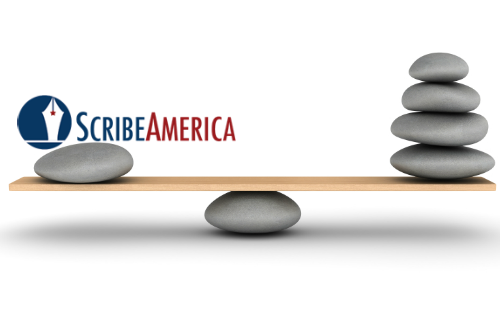Medical scribes and medical scribe vendors are riding a new wave of change in the American healthcare system where doctors and hospitals are being consistently called upon to do more with less. But if there’s one thing to remember in medicine it’s that there’s not always a one size fits all solution for every problem.
Medical scribes work hard to master the complexities of various EHR systems to help doctor’s focus on medical decision making rather than being highly paid data entry specialists. As scribes continue to become the standard practice in emergency departments from coast to coast some groups are critically evaluating their provider to patient staffing ratios and whom they use to work those provider hours.
But when is it the right time to add medical scribes? No doubt the simplistic mind looks at scribes as a line item, but are they really an added cost or if implemented correctly a net revenue item? Would it be a better investment to hire a nurse practitioner (NP), or physician assistant (PA) who potentially can do more within the organization than just document on EHRs?
That answer historically depends on the needs and size of your organization, but I would argue it depends more on the provider to patient staffing ratios, which really should drive decisions about additional coverage. Most large emergency departments with more than 20,000 annual visits likely have the resources and needs to bring on both scribes and PAs/NPs. What if your hospital is smaller than that? Does it make more sense for you to bring on a PA/NP rather than a medical scribe or vice versa?
Looking at the numbers
For many hospitals PAs and NPs have proven to be an effective means of dealing with the demand for more doctors without having to pay the full salary of a doctor. Nationally, the average salary for a Emergency Medicine doctor is about $250,000 per year, versus $87,000 for nurse practitioners, and $79,634 for physician assistants.
However, for an average of $20-$23 per hour you are able to hire a medical scribe with the ability to customize their hours to fit the needs of your organization. So taking an 18k volume ED where you see on average 2 patients per hour but experiences boluses of up to 5 patients per hour. The department may want a PA/NP for about 6 hours per day to cover those busy hours, however cannot hire someone for 6 hours and are forced to pay for a 10 or 12 hour shift and thus significantly affecting the revenue flow. Replacing the PA/NP with a medical scribe will put a spring back in your provider coil and allow you to see those large volumes of patients that you once could not, without one. At the end of the day, you have a net revenue positive of $200,000 annually while not compromising patient care. In today’s Healthcare environment, this is a significant impact on the bottom line.
Medical scribes enable a physician to see and treat more patients.. Whereas a PA or NP can help divert patients with smaller problems away from a doctor to allow them to focus on the most serious cases. A study by medical system reviewer Software Advice found that NPs and PAs on average can perform about 80 percent of the same tasks that a doctor can.
When is a right time to add PA/NP? Well let’s look at a 60k volume ED with an average provider to patient ratio of 2.08. This site has 56 physician hours and 24 PA/NP coverage daily. Due to decreased reimbursement and a new lower payer mix, the emergency department now requires a subsidy from the hospital to keep its doors open. Instead of taking this subsidy why not consider changes to the staffing model to increase your PA/NP utilization and reduce your physician hours? If you were to go to 36 physician hours and increase your PA/NP coverage to 48 hours you could even add 60 hours of medical scribe coverage and be budget positive roughly $320,000.
The above approach reduces the provider to patient ratios to 1.98 and emphasizes the physician as the quarterback, assisting the PA/NP with most cases.
Consult the budget
With those numbers in mind the next step in your decision-making is to consult the budget. Can you really afford to hire, a PA/NP or a medical scribe, considering that reimbursements cuts are a common theme in government discussions.
If the answer is no, you might consider looking at it in another way. Will your organization in its current form be able to effectively weather the big changes taking place in the American healthcare system over the next year? Between the ICD-10 implementation, the Two-Midnight Rule, and the major provisions of the Affordable Care Act taking effect it’s likely you need to be preparing either through hiring additional staff, training existing staff, but more likely, both.
Assess EHR comfort levels
The next step is to assess your physicians’ comfort level with EHR’s. Many physicians find them challenging and get in the way of patient care. National data on EMR implementation has shown, that physician productivity decreases and persists 6 months after implementation. A medical scribe solution could be the best answer and most cost effective
Consult your Press Ganey and HCAPS scores
Next you can consult your Press Ganey and HCAPS scores to see where there is room for improvement, regardless of whether your scores are high or low overall. For example if patients are complaining about long wait times to see a doctor, more than their quality of interaction with the doctor then either a scribe or mid-level provider solution will reduce the door to provider times.
Making your decision
The prevalence of both medical scribes and PAs/NPs are the result of the changing landscape of healthcare in America. Your critical analysis should consider the cost benefit of a scribe or PA/NP, take into account how your physicians are incentivized, and the overall provider and patient satisfaction. It’s important to be prepared for the big changes ahead, but it’s also important to consider other options when increased coverage is demanded.




